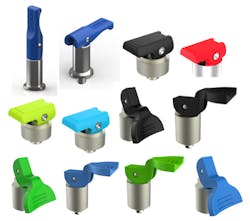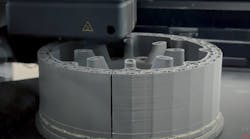While many factory processes are not yet automated, new products in the era of Industry 4.0 must—at the very least—be prepared for automation. Automation technologies require new and complex design considerations that engineers must take into account. We call this set of considerations Design for Automation (DFA).
A DFA-ready product is critically important on the road to Industry 4.0, as it allows manufacturing companies to reduce product costs, decrease assembly time, and increase production volume with zero changes required.
Here are five simple rules to follow as you prepare your products for the future:
1. Think like a robot.
Imagine a robot in an assembly line, with its robotic arms. Compared to human arms, robotic arms are quite limited in their motion range and capabilities. They can, however, be fitted with several different tools depending on the specific needs for assembly—like parallel grippers, vacuum cups and electro-magnets.
When designing a product for automation, it’s important to imagine the robot trying to assemble the parts. See if you can find a way to transfer the part from a tray to the designated location in the assembly line that is convenient not for a human hand but for a robot hand. For example, a magnet would be the easiest way for a robot to grasp a magnetic part; a three-finger gripper would make most sense for a circular part.
2. One direction is best (No, I’m not talking about the boy band).
Many of us have experienced the pleasure of opening a brand-new iPhone from the box. When you open the box, the first thing you see is your shiny new phone. After you remove the phone, you pull out the cover that sits beneath the phone to find all of the phone’s accessories – charger, headphones, manual and more. The method by which Apple assembles this packaging is exactly the opposite of the consumer’s unpackaging experience: start with the box, adding in the various layers, and ending with the box cover.
Now compare this to the assembly of a vehicle. You start with the chassis, add the motor from the top, lower it to the chassis, seats enter from the sides, trunk is assembled from the back, and so on. Assembly, in this case, happens from all directions.
Which of these assemblies is simpler? Answer: the iPhone package, with its one direction. When it comes to the assembly process, directions matter because every time you have to change direction, you also have to change the orientation of the assembly, or the orientation of the tools that you assemble with—therefore increasing the time required to assemble. Obviously, a one-direction assembly is not always possible with complex products, so a good rule of thumb is: the process with the fewest directions of assembly needed is always best.
3. Consider Off the Shelf
All manufacturers rely on off-the-shelf parts (OTS) to complete their products, whether it’s fasteners, dowel pins, electrical connectors or others. To ensure your product is DFA-ready, it is always a good idea to ask yourself if those miscellaneous parts are approachable for automation. I recommend always asking the company from which you buy the parts if they are usable for automation. Sometimes, they may not give you a straight answer. In that case, follow the two rules above.
Take, for example, the commonly used locking plunger (pictured, below). Now ask yourself, “can a robot hold it?” Also, “How many possible directions do we need in order to assemble with this part?”
Through this mental exercise, you’ll probably realize that the button plunger in this second image below—with its rotatable lever—lends itself to automation much better.
4. Prepare for the camera.
Cameras serve an important purpose in an inspection line, locating parts, reading barcodes, counting components and inspecting defects. It’s important to design your DFA-ready parts in a way that can accommodate this important phase of the production cycle. First, if a barcode on a part needs to be read, make sure labels are visible to minimize movement of the robot while assembling. If they are facing the same direction, it will be much easier to apply labels on the product and easier to read their barcode (without changing the camera orientation). Second, when a robot is handling inspection, be sure to define the phase accordingly in order to reduce inspection time as well as faulty rejected parts. For example, scratches on a plate would be quite easy for the human eye to detect, but much more difficult for robotic vision.
5. Don’t forget about the packaging
Just as crucial as the product you produce is the packaging of that product. When designing the packaging, don’t forget to apply the above rules. Not only does DFA-ready packaging allow for quicker assembly, it can also ensure consumers experience that same magical unboxing moment they had with their latest iPhone.
With these simple rules as your guide, your products will be set up for success in the Industry 4.0 era.
Idan Haim is a mechanical designer at software and robotics company Bright Machines. Previously, he held roles as a mechanical engineer at AVT and Q Core Medical. He graduated from Tel Aviv University with a B.S. in mechanical engineering in 2015.






